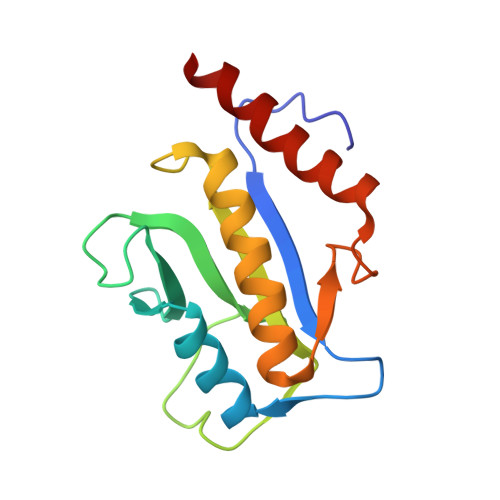Solution structure of ZipA, a crucial component of Escherichia coli cell division.
Moy, F.J., Glasfeld, E., Mosyak, L., Powers, R.(2000) Biochemistry 39: 9146-9156
- PubMed: 10924108
- DOI: https://doi.org/10.1021/bi0009690
- Primary Citation of Related Structures:
1F7W, 1F7X - PubMed Abstract:
ZipA, an essential component of cell division in Escherichia coli, interacts with the FtsZ protein at the midcell in one of the initial steps of septum formation. The high-resolution solution structure of the 144-residue C-terminal domain of E. coli ZipA (ZipA(185)(-)(328)) has been determined by multidimensional heteronuclear NMR. A total of 30 structures were calculated by means of hybrid distance geometry-simulated annealing using a total of 2758 experimental NMR restraints. The atomic root means square distribution about the mean coordinate positions for residues 6-142 for the 30 structures is 0.37 +/- 0.04 A for the backbone atoms, 0. 78 +/- 0.05 A for all atoms, and 0.45 +/- 0.04 A for all atoms excluding disordered side chains. The NMR solution structure of ZipA(185)(-)(328) is composed of three alpha-helices and a beta-sheet consisting of six antiparallel beta-strands where the alpha-helices and the beta-sheet form surfaces directly opposite each other. A C-terminal peptide from FtsZ has been shown to bind ZipA(185)(-)(328) in a hydrophobic channel formed by the beta-sheet providing insight into the ZipA-FtsZ interaction. An unexpected similarity between the ZipA(185)(-)(328) fold and the split beta-alpha-beta fold observed in many RNA binding proteins may further our understanding of the critical ZipA-FtsZ interaction.
Organizational Affiliation:
Department of Biological Chemistry, Wyeth Research, Cambridge, Massachusetts 02140, USA.













